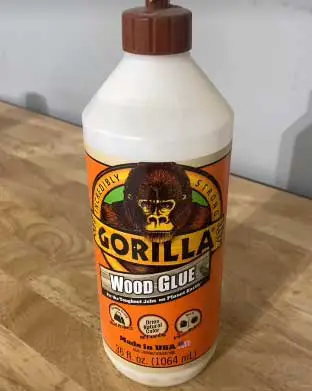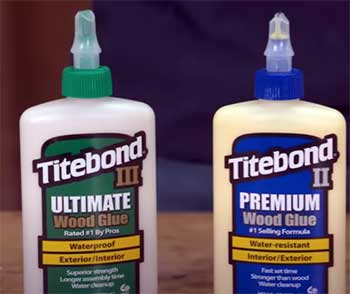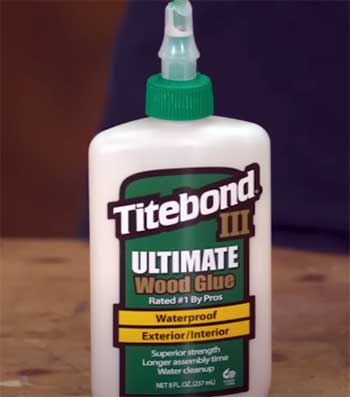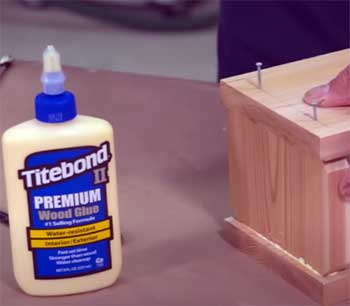I’ve spent countless hours in my workshop, gluing boards, building furniture, and tackling repairs, so I know the glue you choose can make or break a project.
In this article, I’m comparing Gorilla Wood Glue and Titebond, two heavyweights in woodworking adhesives, to help you decide which is best for your needs.
From bond strength to ease of use, I’ll break down their pros and cons, share my experiences, and provide a clear, engaging comparison. By the end, you’ll know which glue suits your projects best.
A Brief Comparison Table
| Feature | Gorilla Wood Glue | Titebond (Original, II, III) |
| Adhesive Type | PVA (Polyvinyl Acetate) with polyurethane | PVA (Polyvinyl Acetate) |
| Bond Strength | Strong, but slightly less than Titebond for wood | Exceptional, often stronger than wood itself |
| Water Resistance | Waterproof (Type II) | Varies: Original (none), II (water-resistant), III (waterproof) |
| Drying Time | 20-30 min clamp, 24 hr cure | 20-60 min clamp, 24 hr cure |
| Open Time | 5-10 minutes | 3-10 minutes (longer for III) |
| Color When Dry | Dries clear to natural wood color | Yellow to brown (varies by type) |
| Ease of Cleanup | Easy with water (wet), sandable (dry) | Easy with water (wet), sandable (dry) |
| Versatility | Bonds wood, some other materials | Wood-specific, excels in woodworking |
| Shelf Life | ~1 year, may dry out if not sealed properly | 1-2 years, longer with proper storage |
| FDA Approval | Yes, for indirect food contact | Yes, for indirect food contact (II and III) |
| Price (8 oz) | ~$4-$6 | ~$4-$8 (varies by type) |
My Journey With Wood Glues
As a woodworker, I’ve had my fair share of glue-related mishaps—joints that wouldn’t hold, messy cleanups, and glues that turned chalky in cold weather. Over the years, I’ve leaned on both Gorilla Wood Glue and Titebond for everything from building bookshelves to crafting outdoor furniture.
Each has its strengths, but choosing the right one depends on your project, environment, and preferences. Let’s break down what makes these glues tick and how they stack up in real-world use.
Gorilla Wood Glue: The Versatile Contender
Gorilla Wood Glue is a PVA-based adhesive with a touch of polyurethane, giving it a unique edge. I first grabbed a bottle when I needed something versatile for a mixed-material project.
It’s marketed as a go-to for indoor and outdoor woodworking, and I’ve found it lives up to that promise in many ways.
Pros of Gorilla Wood Glue

- Strong Initial Tack: One thing I love about Gorilla Wood Glue is its grip. It grabs wood surfaces quickly, which is a lifesaver when you’re juggling multiple pieces during a glue-up. I’ve used it for quick repairs on chair joints, and the fast tack means less slipping while clamping.
- Waterproof for Outdoor Use: This glue is rated Type II for water resistance, meaning it can handle occasional moisture, like rain on outdoor furniture. I built a garden bench with it two years ago, and the joints are still rock-solid despite weathering Midwest storms.
- Dries Clear: Unlike some glues that leave a yellowish tint, Gorilla Wood Glue dries to a natural, nearly clear finish. This is a big win for light-colored woods like maple or pine, where a visible glue line would stand out like a sore thumb. I used it on a pine picture frame, and the joints were practically invisible.
- Versatility Beyond Wood: While it’s marketed for wood, Gorilla Wood Glue can bond other materials like stone, metal, or ceramics. I once used it to repair a ceramic-wood hybrid sculpture, and it held up beautifully where a standard wood glue might’ve failed.
- Easy Cleanup: Spills and squeeze-out clean up easily with a damp rag when wet, and it’s sandable once dry. I’ve never had issues cleaning my tools or workbench after using it, which saves me time and frustration.
Cons of Gorilla Wood Glue
- Slightly Weaker Bond for Heavy-Duty Woodworking: While strong, Gorilla Wood Glue doesn’t always match Titebond’s sheer bond strength for wood-to-wood joints. In my experience, it’s great for lighter projects, but for heavy structural work, like a load-bearing beam, I’ve seen it underperform compared to Titebond III.
- Shelf Life Issues: I’ve had bottles of Gorilla Wood Glue dry out or thicken within a year, especially if not sealed tightly. Once, I opened a bottle only to find it had turned into a gummy mess, forcing me to run to the store mid-project. Proper storage (like squeezing out air and keeping it cool) helps, but it’s a hassle.
- Not Ideal for High-Stress Joints: For joints under constant stress, like chair legs or tabletops, Gorilla Wood Glue can sometimes fail to deliver. I once glued a mitre joint for a table base, and while it held initially, it started to creak after a year of heavy use.
- Limited Open Time: With an open time of 5-10 minutes, you need to work fast. I’ve had moments where I misaligned pieces and struggled to adjust them before the glue started setting, which can be stressful during complex glue-ups.
Titebond: The Woodworker’s Gold Standard
Titebond is a name that echoes through woodworking shops, and for good reason. With three main variants—Original, II Premium, and III Ultimate—it’s a brand that caters to specific needs.
I’ve used all three over the years, and each has its place in my toolkit.
Pros of Titebond

- Unmatched Bond Strength: Titebond’s claim to fame is its bond strength, often stronger than the wood itself. I’ve tested this firsthand: when I tried breaking apart a glued oak panel, the wood splintered before the glue joint gave way. This makes it my go-to for furniture, cabinetry, and structural projects.
- Variety for Every Need: Titebond’s range is a huge plus. Original is great for indoor projects like picture frames, II offers water resistance for semi-outdoor use, and III is fully waterproof for harsh conditions. I used Titebond III for a cedar deck post wrap, and it’s held up through three years of rain and snow.
- Long Shelf Life: With proper storage, Titebond lasts longer than Gorilla Wood Glue. I’ve kept bottles of Titebond II for over two years without noticing any degradation, even in my unheated garage. Just cap it tightly and store it at room temperature.
- FDA-Approved for Safety: Both Titebond II and III are FDA-approved for indirect food contact, making them safe for cutting boards or kitchen utensils. I’ve used Titebond III for a butcher block, and it’s reassuring to know it’s non-toxic once cured.
- Easy to Work With: Titebond spreads smoothly and cleans up easily with water when wet. It’s also sandable and paintable once dry. I’ve never had issues with it gumming up my tools or leaving a mess on my workbench.
Cons of Titebond
- Visible Glue Line: Titebond dries to a yellowish-brown color, which can show on light woods. I learned this the hard way when a maple box I made had noticeable glue lines, forcing me to sand more than I’d planned.
- Temperature Sensitivity: Titebond doesn’t like cold weather. I once tried gluing in my chilly workshop (around 40°F), and the glue turned chalky, ruining the joint. You need a warm environment (above 50°F) for best results, which can be a pain in unheated spaces.
- Limited Versatility: Titebond is wood-specific. If you’re working with mixed materials, like wood and metal, it’s not the best choice. I tried using Titebond II to bond wood to a metal bracket, and the joint failed within weeks.
- Longer Clamp Time for Some Variants: Titebond III, while waterproof, requires up to an hour of clamping, which can slow down projects. I’ve found myself waiting longer than I’d like when using it for outdoor builds, compared to Gorilla’s quicker set time.
Head-to-Head Comparison of Gorilla Wood Glue And Titebond
Let’s get into the meat of the comparison, focusing on the features that matter most to woodworkers like you and me. I’ve broken this down into critical aspects to help you see how Gorilla Wood Glue and Titebond perform in real-world scenarios.
- Bond Strength and Durability

When it comes to holding wood together, Titebond is the clear winner.
Its PVA formula creates bonds so strong that the wood often breaks before the glue does.
I’ve used Titebond II for a dining table, and after five years of daily use, the joints are as solid as ever.
Gorilla Wood Glue, while strong, doesn’t quite reach the same level for wood-to-wood joints.
Its polyurethane additive gives it an edge for mixed materials, but for pure woodworking, Titebond’s reliability is unmatched.
- Water Resistance
Water resistance is crucial for outdoor projects or items exposed to moisture. Gorilla Wood Glue is Type II water-resistant, meaning it can handle occasional splashes or rain. I’ve used it for outdoor chairs, and it’s held up well.
Titebond III, however, is Type I waterproof, making it the go-to for harsh conditions like constant rain or high humidity. Titebond II is water-resistant but not as robust as III, while Original offers no water resistance. If your project lives outside, Titebond III is your best bet.
- Drying and Clamp Time
Both glues set relatively quickly, but Gorilla Wood Glue has a slight edge with a 20-30 minute clamp time compared to Titebond’s 20-60 minutes (depending on the variant). I’ve found Gorilla’s faster set helpful for quick repairs, like fixing a wobbly chair leg.
However, Titebond III’s longer open time (up to 10 minutes) is a boon for complex assemblies where you need to adjust pieces before clamping.
- Appearance and Finish
Gorilla Wood Glue dries clear, blending seamlessly with light woods. I used it on a birch shelf, and the joints were nearly invisible. Titebond, especially III, dries to a brownish hue, which can be noticeable on lighter woods like pine or maple.
If aesthetics matter, Gorilla is the better choice for visible joints, while Titebond works best for darker woods or painted projects.
- Ease of Use and Cleanup
Both glues are user-friendly, spreading easily and cleaning up with water when wet. I’ve spilled both on my workbench, and a damp rag took care of the mess in seconds.
Once dry, they’re sandable and paintable, though Titebond’s smoother consistency makes it slightly easier to apply evenly. Gorilla’s thicker formula can sometimes clump if you’re not careful.
- Versatility
Gorilla Wood Glue’s ability to bond non-wood materials gives it an edge for mixed-media projects. I’ve used it to attach wood to ceramic tiles for a decorative piece, and it worked like a charm. Titebond, however, is strictly for wood, which limits its use in creative or unconventional projects.
If you’re sticking to woodworking, Titebond’s specialized formula is ideal; for broader applications, Gorilla shines.
- Shelf Life and Storage
Titebond wins here. I’ve had bottles last over two years with no issues, as long as they’re sealed tightly and stored at room temperature. Gorilla Wood Glue, in my experience, tends to thicken or dry out within a year if not stored carefully.
I’ve started keeping it in a ziplock bag to extend its life, but it’s an extra step I don’t need with Titebond.
- Safety and Environmental Impact
Both glues are non-toxic and FDA-approved for indirect food contact, making them safe for kitchen projects like cutting boards. They’re also water-based, so cleanup doesn’t involve harsh solvents, which is better for the environment.
I’ve never had health concerns with either, but I always work in a well-ventilated area to avoid inhaling fumes.
- Price and Value
Price-wise, both are comparable, with 8-ounce bottles ranging from $4-$8. Gorilla Wood Glue is often slightly cheaper, but Titebond’s longer shelf life and stronger bond make it a better value for frequent woodworkers.
I buy Titebond in gallon jugs for bigger projects, which saves money over time.
Also Read: Comparison of Gunther Mirror Mastic And Loctite Adhesives.
My Experiences With Gorilla Wood Glue And Titebond
To give you a sense of how these glues perform, let me share a few projects where I’ve used them.

- Indoor Furniture: Titebond’s Domain: For a walnut coffee table, I used Titebond II. The joints were tight, and the glue’s strength ensured the table could handle daily use, including kids climbing on it. The yellowish glue line wasn’t an issue since walnut is dark, and the bond has held for years.
- Outdoor Projects: A Toss-Up: For a cedar planter box, I chose Titebond III for its waterproof rating. It’s survived two winters without a hitch. But for a quick outdoor repair on a fence post, Gorilla Wood Glue’s faster set time and water resistance were perfect, and the clear finish kept the repair discreet.
- Mixed-Material Projects: Gorilla’s Edge: I once built a display stand combining wood and metal. Gorilla Wood Glue’s versatility made it the better choice, as Titebond wouldn’t stick to the metal components. The bond held firm, and the project still looks great.
- Repairs: Both Shine: For quick fixes, like reattaching a loose chair rung, both glues work well. Gorilla’s fast tack is handy for small repairs, but Titebond’s strength is better for long-term durability. I keep both in my shop for different scenarios.
Which Glue Wins?
From an analytical standpoint, Titebond is the superior choice for most woodworking projects. Its bond strength, variety of formulations, and reliability make it a staple in professional and hobbyist shops alike.
I’ve never had a Titebond joint fail when applied correctly, and its long shelf life means I’m not wasting money on spoiled glue. However, Gorilla Wood Glue’s versatility, clear finish, and faster set time make it a strong contender for specific applications, especially mixed-material or outdoor projects where aesthetics matter.
The choice comes down to your project’s needs. If you’re building heavy-duty furniture or working exclusively with wood, Titebond’s specialized formulas are hard to beat. If you need a glue that can handle diverse materials or dries invisibly, Gorilla Wood Glue is your friend.
I often keep both on hand, using Titebond for serious woodworking and Gorilla for quick fixes or creative projects.
Also Read: Alternatives To AirStone Adhesive.
FAQ: Your Questions Answered
Titebond is generally better for wood-to-wood joints due to its superior bond strength and reliability. Gorilla Wood Glue is a good alternative for versatile or aesthetic-focused projects.
Gorilla Wood Glue has a shorter shelf life, slightly weaker bond for heavy-duty woodworking, and limited open time, which can make complex glue-ups tricky.
Titebond III is widely regarded as the strongest wood glue, often outperforming the wood itself in strength tests.
Gorilla Wood Glue is strong but typically not as strong as Titebond for wood-to-wood joints. Its polyurethane additive boosts versatility but doesn’t match Titebond’s wood-specific bond.
Conclusion: Your Glue, Your Choice
You’re now armed with everything you need to choose between Gorilla Wood Glue and Titebond for your next project. If you’re like me, you’ll probably find a place for both in your workshop.
Titebond’s unmatched strength and variety make it the go-to for serious woodworking, while Gorilla Wood Glue’s versatility and clear finish are perfect for quick fixes or mixed-material builds. Consider your project’s demands—strength, water resistance, aesthetics—and pick the glue that fits.
Happy woodworking, and may your joints always hold tight!
